Python Training in Bangalore | Multi threading | Learnbay.in
Download as PPTX, PDF2 likes761 views
Learn Multi threading in Python .How to create threads in Python. About Race Condition. Learnbay provides python training in Bangalore for network automation.
1 of 7
Downloaded 14 times

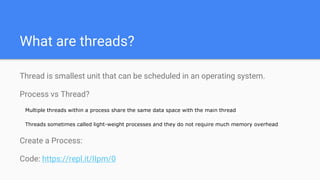
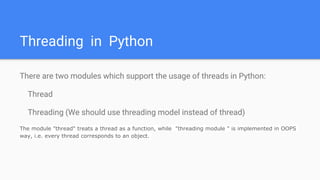



![Create a thread - Threading Module
Follow below steps:
Construct a subclass from the <Thread> class.
Override the <__init__(self [,args])> method to provide arguments.
override the <run(self [,args])> method to code the actual required logic of the thread.
When start is called on instance of Thread subclass,it eventually calls overridden run method.](https://image.slidesharecdn.com/multithreading-170602072056/85/Python-Training-in-Bangalore-Multi-threading-Learnbay-in-7-320.jpg)
Recommended
Python multithreading session 9 - shanmugam



Python multithreading session 9 - shanmugamNavaneethan Naveen
Ěý
- Python allows programmers to write multi-threaded programs using its threading module. This allows running multiple threads concurrently to perform asynchronous tasks or operations in parallel.
- The threading module provides Thread class which represents a thread of execution. New threads can be created by subclassing Thread and overriding its run method. start() method launches the execution of the thread.
- Synchronization between threads is important to prevent race conditions. The threading module provides Lock objects to synchronize access to shared resources.Python multithreading



Python multithreadingSmt. Indira Gandhi College of Engineering, Navi Mumbai, Mumbai
Ěý
- Python allows programmers to write multithreaded programs that run multiple threads concurrently for more efficient use of resources and responsiveness.
- The main benefits of multithreading over multiple processes are that threads within a process can share data and resources more easily. Threads also have less memory overhead than processes.
- There are two main modules for multithreading in Python - the older thread module and the newer threading module, which provides more powerful features and methods for managing threads.Threads in python



Threads in pythonbaabtra.com - No. 1 supplier of quality freshers
Ěý
This document provides a summary of threads in Python. It begins by defining what a thread is and how it allows for multitasking by time-division multiplexing the processor between threads. It then discusses how to start new threads in Python using the thread and threading modules, including examples. It also covers how to create threads that subclass the Thread class and how to synchronize threads using locks.concurrency



concurrencyJonathan Wagoner
Ěý
This document provides a brief overview of concurrency concepts in Python, focusing on threading. It defines processes and threads, explaining that threads run within a process and can share resources, while processes are independent and communicate via interprocess communication. It discusses why to use concurrency for performance, responsiveness, and non-blocking behavior. It also covers the Global Interpreter Lock in Python and its implications for threading, and provides examples of creating and running threads.Multithreading in Java



Multithreading in JavaAppsterdam Milan
Ěý
The document discusses multithreading in Java, including the evolution of threading support across Java releases and examples of implementing multithreading using Threads, ExecutorService, and NIO channels. It also provides examples of how to make operations thread-safe using locks and atomic variables when accessing shared resources from multiple threads. References are included for further reading on NIO-based servers and asynchronous channel APIs introduced in Java 7..NET Multithreading/Multitasking



.NET Multithreading/MultitaskingSasha Kravchuk
Ěý
This document discusses multithreading and concurrency in .NET. It covers key concepts like processes and threads, and how they relate on an operating system level. It also discusses the Thread Pool, Task Parallel Library (TPL), Tasks, Parallel LINQ (PLINQ), and asynchronous programming patterns in .NET like async/await. Examples are provided for common threading techniques like producer/consumer and using the Timer class. Overall it serves as a comprehensive overview of multithreading and concurrency primitives available in the .NET framework.Threading



Threadingabhay singh
Ěý
This document discusses multithreading and threading concepts in .NET. It defines threading as running multiple parts of a program concurrently using threads. Each thread defines a separate execution path. The .NET Framework supports both process-based and thread-based multitasking. Threads are represented by the Thread class and can be created and managed. Methods like Start(), Join(), and Sleep() are used to control thread execution. Thread priorities can be set to influence thread scheduling order.multi threading



multi threadingYaswanth Babu Gummadivelli
Ěý
Multithreading allows multiple tasks to be performed simultaneously by executing independent threads. There are two methods for creating threads in C#: using the Thread class or the thread pool. Threads have a lifecycle that includes creation, execution, and termination. Synchronization is used to coordinate thread access to shared resources using locks, and threads can communicate through wait/pulse methods that pause execution until notified of state changes. Potential issues like deadlocks can occur if threads indefinitely wait for each other.Multithreading Concepts



Multithreading ConceptsArvind Krishnaa
Ěý
The document discusses various concepts related to multithreading in Java including thread-safe collections, executors, and synchronizers. It provides details on blocking queues, concurrent hash maps, executors that allow submitting tasks to thread pools, and synchronizers like cyclic barriers, countdown latches, and semaphores that help manage groups of threads. It also discusses how to update Swing components safely from multiple threads using EventQueue methods like invokeLater().Java Multithreading Using Executors Framework



Java Multithreading Using Executors FrameworkArun Mehra
Ěý
This document provides an overview of using executors to handle multithreading in Java. It discusses key classes and interfaces in the executors framework like Executor, ExecutorService, and Executors. Common thread pools like fixed thread pool and cached thread pool are mentioned. The document also summarizes techniques for naming threads, returning values from threads, creating daemon threads, checking thread status, terminating threads, and handling uncaught exceptions using both the thread and executor APIs. Finally, it covers scheduling tasks using both the timer/timerTask classes and executor service.Python multithreaded programming



Python multithreaded programmingLearnbay Datascience
Ěý
This presentation educates you about Python - Multithreaded
Programming, Starting a New Thread, The Threading Module, Creating Thread Using Threading Module, Synchronizing Threads and Multithreaded Priority Queue.
For more topics stay tuned with Learnbay.Java Thread & Multithreading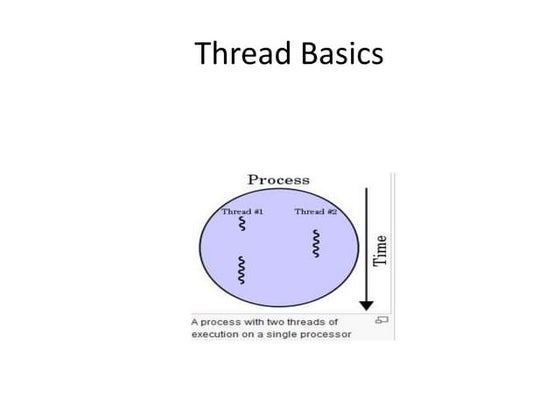



Java Thread & Multithreadingjehan1987
Ěý
This document discusses threads and multithreading. It defines a thread as the smallest sequence of instructions that can be managed independently, and notes that multithreading allows a program to manage multiple tasks concurrently. Benefits of multithreading include improved responsiveness, faster execution on multi-core CPUs, lower resource usage, better system utilization, simplified communication between threads, and enabling parallelization. Challenges with multithreading include synchronization between threads accessing shared data and resources, and the risk that a misbehaving thread can crash the entire process. The document provides examples of creating threads in Java using the Runnable interface and by extending the Thread class.Multithreading Introduction and Lifecyle of thread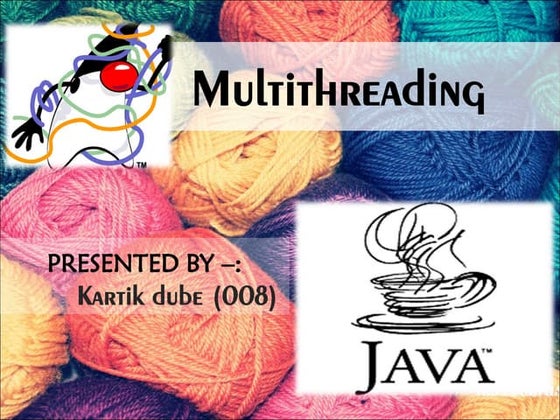



Multithreading Introduction and Lifecyle of threadKartik Dube
Ěý
:::::::All about Multithreading , Lifecylce of thread and Very simple Program for syncronization:::::::
Java Multithreading and Concurrency



Java Multithreading and ConcurrencyRajesh Ananda Kumar
Ěý
This presentation is about advanced multithreading and concurrency in Java. I have tried my best to explain the concepts with code. Feel free to reach me if you have any questions or concerns.Intro To .Net Threads



Intro To .Net Threadsrchakra
Ěý
This document provides an overview of threading concepts in .NET, including:
1) Threads allow concurrent execution within a process and each thread has its own call stack. The CLR uses thread pools to improve efficiency of asynchronous operations.
2) Thread synchronization is required when threads access shared resources to prevent race conditions and deadlocks. The .NET framework provides classes like Monitor, Lock, and Interlocked for thread synchronization.
3) Limiting threads improves performance on single-CPU systems due to reduced context switching overhead.Multi-threaded Programming in JAVA



Multi-threaded Programming in JAVAVikram Kalyani
Ěý
This presentation contains the topic Multi Threaded Programming in JAVA.
Sources from all over internet.Threading in C#



Threading in C#Medhat Dawoud
Ěý
This document discusses multithreading in C#. It introduces threads and multithreading, describing how operating systems allow multitasking and how threads work. It explains that the .NET Framework supports multithreading using the System.Threading namespace and Thread class. It describes properties and methods of the Thread class, potential problems like deadlocks that can occur with multithreading, and solutions like synchronization and locking to prevent issues.Java concurrency - Thread pools



Java concurrency - Thread poolsmaksym220889
Ěý
Presentation describes basic concepts of thread pool such as:
- interacting with queues,
- using pools from Executors class,
- task rejecting
- using ThreadFactory for thread creating
- Future and Callable interfaces,
- basic API
- possibilities for extending Basic of Multithreading in JAva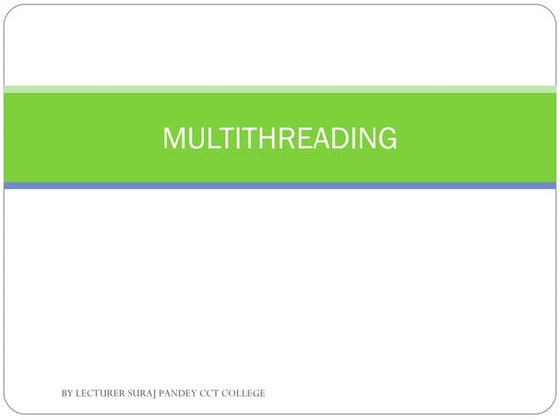



Basic of Multithreading in JAvasuraj pandey
Ěý
The document discusses multithreading in Java. It defines multithreading as executing multiple threads simultaneously, with threads being lightweight subprocesses that share a common memory area. This allows multitasking to be achieved more efficiently than with multiprocessing. The advantages of multithreading include not blocking the user, performing operations together to save time, and exceptions in one thread not affecting others. The document also covers thread states, creating and starting threads, and common thread methods.Multithreading in java



Multithreading in javajunnubabu
Ěý
easy to understand...and easy to learn...
in this ppt covers all topics in multithreading concept in java...Threads c sharp



Threads c sharpDeivaa
Ěý
This document discusses C# threads and thread synchronization. It begins by explaining how threads are represented by the Thread class in C# and how to start a thread by passing a delegate to its constructor. It then discusses thread states and properties like priority. It describes how threads need synchronization mechanisms when sharing resources and demonstrates this with a parent-child thread example using a shared queue. Finally, it covers various .NET synchronization primitives like locks, monitors, and reader-writer locks and how to synchronize access to collections and methods.Multithread Programing in Java



Multithread Programing in JavaM. Raihan
Ěý
Multithreading is the ability of a program or an
operating system process to manage its use by
more than one user at a time and to even manage
multiple requests by the same user without
having to have multiple copies of the
programming running in the computer.Learning Java 3 –ĚýThreads and Synchronization



Learning Java 3 –ĚýThreads and Synchronizationcaswenson
Ěý
This document provides an overview of threads and synchronization in Java. It discusses how to create threads by implementing Runnable or extending Thread, how to start and stop threads, and useful thread methods like sleep and yield. It explains the need for synchronization when multiple threads access shared resources and can step on each other. Synchronization is achieved using locks on objects, synchronized methods, and wait/notify calls on objects. More advanced synchronization mechanisms introduced in Java 5 like ReentrantLock and Condition variables are also briefly mentioned.Multithreading in java



Multithreading in javaArafat Hossan
Ěý
Multithreading allows a program to split into multiple subprograms called threads that can run concurrently. Threads go through various states like new, runnable, running, blocked, and dead. There are two main ways to create threads: by extending the Thread class or implementing the Runnable interface. Threads can have different priorities that influence scheduling order. Multithreading allows performing multiple operations simultaneously to save time without blocking the user, and exceptions in one thread do not affect others.Threads c sharp



Threads c sharpKarthick Suresh
Ěý
This document discusses C# threads and threading concepts in 3 paragraphs:
C# threads are managed by the System.Threading.Thread class and are passed a function using a ThreadStart delegate. Threads can be started and have properties like IsBackground that indicate their state.
When threads share resources, synchronization is needed to serialize access. The C# lock statement can be used to synchronize access to shared resources like queues. Other synchronization primitives like Monitor, Interlocked, and ReaderWriterLock are also available.
User interface threads in Windows Forms are separate from worker threads that do background processing. Worker threads must communicate with UI threads using Form methods like Invoke, BeginInvoke, and EndInvokeConcurrency in java



Concurrency in javaAbhra Basak
Ěý
This document provides an overview of concurrency and parallelism in the Java runtime environment. It discusses the Java thread model and decisions for its design. It also covers implementing multithreading by creating and managing threads, remote method execution using Java RMI, concurrency utilities in java.util.concurrent, thread safety and shared data access, and GUI applications in Java. The document lists several references for further reading on Java concurrency topics.Java Multithreading



Java MultithreadingRajkattamuri
Ěý
This document discusses Java multithreading. It explains that multithreading allows an application to have multiple points of execution within the same memory space. It outlines how Java supports multithreading through the Thread class and Runnable interface. It also describes concurrency issues that can arise from multithreading, such as race conditions, and how to address them using techniques like synchronized access and locking.Multithreading in java



Multithreading in javaRaghu nath
Ěý
Multithreading allows programs to have multiple threads that can run concurrently. Each thread defines a separate path of execution. Processes are programs that are executing, while threads exist within a process and share its resources. Creating a new thread requires fewer resources than creating a new process. There are two main ways to define a thread - by implementing the Runnable interface or by extending the Thread class.Multithreaded_Programming_in_Python.pdf



Multithreaded_Programming_in_Python.pdfgiridharsripathi
Ěý
Multithreading allows programs to execute multiple tasks simultaneously by breaking tasks into independent threads that can run in parallel. In Python, the threading and _thread modules provide tools for multithreading. Threads share common memory and context switching between threads is faster than processes. The global interpreter lock in Python means only one thread can execute at a time, limiting true parallelism.Multithreading by rj



Multithreading by rjShree M.L.Kakadiya MCA mahila college, Amreli
Ěý
The document discusses multithreaded programming in Python. It covers threads and the threading module, the difference between single-threaded and multithreaded execution, and provides an example of multithreading. Key points include that threads are lightweight processes that can run concurrently within a larger parent process and share resources like memory. The threading module provides higher-level thread management compared to the lower-level thread module.More Related Content
What's hot (20)
Multithreading Concepts



Multithreading ConceptsArvind Krishnaa
Ěý
The document discusses various concepts related to multithreading in Java including thread-safe collections, executors, and synchronizers. It provides details on blocking queues, concurrent hash maps, executors that allow submitting tasks to thread pools, and synchronizers like cyclic barriers, countdown latches, and semaphores that help manage groups of threads. It also discusses how to update Swing components safely from multiple threads using EventQueue methods like invokeLater().Java Multithreading Using Executors Framework



Java Multithreading Using Executors FrameworkArun Mehra
Ěý
This document provides an overview of using executors to handle multithreading in Java. It discusses key classes and interfaces in the executors framework like Executor, ExecutorService, and Executors. Common thread pools like fixed thread pool and cached thread pool are mentioned. The document also summarizes techniques for naming threads, returning values from threads, creating daemon threads, checking thread status, terminating threads, and handling uncaught exceptions using both the thread and executor APIs. Finally, it covers scheduling tasks using both the timer/timerTask classes and executor service.Python multithreaded programming



Python multithreaded programmingLearnbay Datascience
Ěý
This presentation educates you about Python - Multithreaded
Programming, Starting a New Thread, The Threading Module, Creating Thread Using Threading Module, Synchronizing Threads and Multithreaded Priority Queue.
For more topics stay tuned with Learnbay.Java Thread & Multithreading



Java Thread & Multithreadingjehan1987
Ěý
This document discusses threads and multithreading. It defines a thread as the smallest sequence of instructions that can be managed independently, and notes that multithreading allows a program to manage multiple tasks concurrently. Benefits of multithreading include improved responsiveness, faster execution on multi-core CPUs, lower resource usage, better system utilization, simplified communication between threads, and enabling parallelization. Challenges with multithreading include synchronization between threads accessing shared data and resources, and the risk that a misbehaving thread can crash the entire process. The document provides examples of creating threads in Java using the Runnable interface and by extending the Thread class.Multithreading Introduction and Lifecyle of thread



Multithreading Introduction and Lifecyle of threadKartik Dube
Ěý
:::::::All about Multithreading , Lifecylce of thread and Very simple Program for syncronization:::::::
Java Multithreading and Concurrency



Java Multithreading and ConcurrencyRajesh Ananda Kumar
Ěý
This presentation is about advanced multithreading and concurrency in Java. I have tried my best to explain the concepts with code. Feel free to reach me if you have any questions or concerns.Intro To .Net Threads



Intro To .Net Threadsrchakra
Ěý
This document provides an overview of threading concepts in .NET, including:
1) Threads allow concurrent execution within a process and each thread has its own call stack. The CLR uses thread pools to improve efficiency of asynchronous operations.
2) Thread synchronization is required when threads access shared resources to prevent race conditions and deadlocks. The .NET framework provides classes like Monitor, Lock, and Interlocked for thread synchronization.
3) Limiting threads improves performance on single-CPU systems due to reduced context switching overhead.Multi-threaded Programming in JAVA



Multi-threaded Programming in JAVAVikram Kalyani
Ěý
This presentation contains the topic Multi Threaded Programming in JAVA.
Sources from all over internet.Threading in C#



Threading in C#Medhat Dawoud
Ěý
This document discusses multithreading in C#. It introduces threads and multithreading, describing how operating systems allow multitasking and how threads work. It explains that the .NET Framework supports multithreading using the System.Threading namespace and Thread class. It describes properties and methods of the Thread class, potential problems like deadlocks that can occur with multithreading, and solutions like synchronization and locking to prevent issues.Java concurrency - Thread pools



Java concurrency - Thread poolsmaksym220889
Ěý
Presentation describes basic concepts of thread pool such as:
- interacting with queues,
- using pools from Executors class,
- task rejecting
- using ThreadFactory for thread creating
- Future and Callable interfaces,
- basic API
- possibilities for extending Basic of Multithreading in JAva



Basic of Multithreading in JAvasuraj pandey
Ěý
The document discusses multithreading in Java. It defines multithreading as executing multiple threads simultaneously, with threads being lightweight subprocesses that share a common memory area. This allows multitasking to be achieved more efficiently than with multiprocessing. The advantages of multithreading include not blocking the user, performing operations together to save time, and exceptions in one thread not affecting others. The document also covers thread states, creating and starting threads, and common thread methods.Multithreading in java



Multithreading in javajunnubabu
Ěý
easy to understand...and easy to learn...
in this ppt covers all topics in multithreading concept in java...Threads c sharp



Threads c sharpDeivaa
Ěý
This document discusses C# threads and thread synchronization. It begins by explaining how threads are represented by the Thread class in C# and how to start a thread by passing a delegate to its constructor. It then discusses thread states and properties like priority. It describes how threads need synchronization mechanisms when sharing resources and demonstrates this with a parent-child thread example using a shared queue. Finally, it covers various .NET synchronization primitives like locks, monitors, and reader-writer locks and how to synchronize access to collections and methods.Multithread Programing in Java



Multithread Programing in JavaM. Raihan
Ěý
Multithreading is the ability of a program or an
operating system process to manage its use by
more than one user at a time and to even manage
multiple requests by the same user without
having to have multiple copies of the
programming running in the computer.Learning Java 3 –ĚýThreads and Synchronization



Learning Java 3 –ĚýThreads and Synchronizationcaswenson
Ěý
This document provides an overview of threads and synchronization in Java. It discusses how to create threads by implementing Runnable or extending Thread, how to start and stop threads, and useful thread methods like sleep and yield. It explains the need for synchronization when multiple threads access shared resources and can step on each other. Synchronization is achieved using locks on objects, synchronized methods, and wait/notify calls on objects. More advanced synchronization mechanisms introduced in Java 5 like ReentrantLock and Condition variables are also briefly mentioned.Multithreading in java



Multithreading in javaArafat Hossan
Ěý
Multithreading allows a program to split into multiple subprograms called threads that can run concurrently. Threads go through various states like new, runnable, running, blocked, and dead. There are two main ways to create threads: by extending the Thread class or implementing the Runnable interface. Threads can have different priorities that influence scheduling order. Multithreading allows performing multiple operations simultaneously to save time without blocking the user, and exceptions in one thread do not affect others.Threads c sharp



Threads c sharpKarthick Suresh
Ěý
This document discusses C# threads and threading concepts in 3 paragraphs:
C# threads are managed by the System.Threading.Thread class and are passed a function using a ThreadStart delegate. Threads can be started and have properties like IsBackground that indicate their state.
When threads share resources, synchronization is needed to serialize access. The C# lock statement can be used to synchronize access to shared resources like queues. Other synchronization primitives like Monitor, Interlocked, and ReaderWriterLock are also available.
User interface threads in Windows Forms are separate from worker threads that do background processing. Worker threads must communicate with UI threads using Form methods like Invoke, BeginInvoke, and EndInvokeConcurrency in java



Concurrency in javaAbhra Basak
Ěý
This document provides an overview of concurrency and parallelism in the Java runtime environment. It discusses the Java thread model and decisions for its design. It also covers implementing multithreading by creating and managing threads, remote method execution using Java RMI, concurrency utilities in java.util.concurrent, thread safety and shared data access, and GUI applications in Java. The document lists several references for further reading on Java concurrency topics.Java Multithreading



Java MultithreadingRajkattamuri
Ěý
This document discusses Java multithreading. It explains that multithreading allows an application to have multiple points of execution within the same memory space. It outlines how Java supports multithreading through the Thread class and Runnable interface. It also describes concurrency issues that can arise from multithreading, such as race conditions, and how to address them using techniques like synchronized access and locking.Multithreading in java



Multithreading in javaRaghu nath
Ěý
Multithreading allows programs to have multiple threads that can run concurrently. Each thread defines a separate path of execution. Processes are programs that are executing, while threads exist within a process and share its resources. Creating a new thread requires fewer resources than creating a new process. There are two main ways to define a thread - by implementing the Runnable interface or by extending the Thread class.Similar to Python Training in Bangalore | Multi threading | Learnbay.in (20)
Multithreaded_Programming_in_Python.pdf



Multithreaded_Programming_in_Python.pdfgiridharsripathi
Ěý
Multithreading allows programs to execute multiple tasks simultaneously by breaking tasks into independent threads that can run in parallel. In Python, the threading and _thread modules provide tools for multithreading. Threads share common memory and context switching between threads is faster than processes. The global interpreter lock in Python means only one thread can execute at a time, limiting true parallelism.Multithreading by rj



Multithreading by rjShree M.L.Kakadiya MCA mahila college, Amreli
Ěý
The document discusses multithreaded programming in Python. It covers threads and the threading module, the difference between single-threaded and multithreaded execution, and provides an example of multithreading. Key points include that threads are lightweight processes that can run concurrently within a larger parent process and share resources like memory. The threading module provides higher-level thread management compared to the lower-level thread module.Md09 multithreading



Md09 multithreadingRakesh Madugula
Ěý
The document discusses threads and multithreading in Java. It defines a thread as a flow of execution with a beginning, execution sequence, and end. Multithreading allows multiple threads to run simultaneously within a single program. It describes how to create threads by extending the Thread class or implementing Runnable. The document also discusses thread states, priorities, synchronization, and race conditions that can occur when multiple threads access shared data.MULTI THREADING.pptx



MULTI THREADING.pptxKeerthanaM738437
Ěý
This document discusses multi-threading in Python. It defines processes and threads, and notes that threads are lighter weight than processes. It describes how threads can share data and resources, unlike processes. The document also covers thread life cycles, different types of threads, threading modules for creating and managing threads, synchronizing threads using locks, daemon threads, priority queues for managing threads, and an example of passing a class as an argument in a priority queue.Multi t hreading_14_10



Multi t hreading_14_10Minal Maniar
Ěý
This document discusses multithreading in Java. It defines threads as lightweight processes that exist within a process and share its resources. The main thread is executed when a Java program begins. Additional threads can be created by implementing the Runnable interface or extending the Thread class. Synchronization is needed when threads access shared resources to prevent interference. Methods can be synchronized to allow only one thread to access them at a time. The wait(), notify(), and notifyAll() methods allow threads to communicate about locked resources. Deadlocks can occur when threads have a circular dependency on locks. The Java concurrency utilities provide additional tools for multithreaded programming.multithreading



multithreadingRajkattamuri
Ěý
This document provides an overview of multithreading in Java. It describes how multithreading allows an application to perform multiple tasks simultaneously through the use of threads. It explains that threads allow applications to remain responsive even when long tasks are being performed. The document outlines how threads work in Java, including how to create threads using the Thread and Runnable classes, the different states threads can be in, and common concurrency issues that can arise with multithreading like race conditions.Multithreading



MultithreadingF K
Ěý
This document discusses multithreading in Java. It explains that multithreading allows an application to have multiple points of execution within the same memory space. This improves responsiveness by allowing tasks to be performed concurrently rather than sequentially. The document outlines how threads are implemented in Java using the Thread class and Runnable interface, and discusses issues like concurrency, shared resources, thread states, priorities and synchronization.Java



Javamdfkhan625
Ěý
This document discusses multithreading in Java. It begins by explaining that multithreading allows multiple tasks to be performed concurrently by having each task executed in a separate thread. It then covers key topics like how threads are implemented in Java using the Thread class and Runnable interface, how to create and manage threads, common thread states, ensuring thread safety through synchronization, and techniques to improve synchronization performance.Multithreading



MultithreadingRavi Chythanya
Ěý
This document discusses multithreading in Java. It begins by explaining the difference between single-threaded and multithreaded programs. A multithreaded program contains two or more threads that can run concurrently. Each thread defines a separate path of execution. The document then covers key aspects of multithreading like creating threads by extending the Thread class or implementing the Runnable interface, starting and controlling threads, thread priorities, synchronization, and inter-thread communication.Java



JavaKhasim Cise
Ěý
This document discusses multithreading in Java. It defines multithreading as having multiple points of execution within the same memory space that can share access to resources. The key benefits of multithreading are that applications can perform multiple tasks simultaneously and remain responsive even when long tasks are being performed. The document outlines how threads are implemented in Java using the Thread class and Runnable interface, and discusses concepts like thread states, priorities, and concurrency issues that must be addressed.Java multithreading



Java multithreadingMohammed625
Ěý
This document discusses Java multithreading. It begins by outlining the objectives of understanding multithreading, Java's mechanism, concurrency issues, and synchronized access. It then explains that multithreading allows multiple threads to run simultaneously within a process's memory space. Finally, it covers key topics like creating and running threads, thread states, priorities, and ensuring thread-safe access to shared resources through synchronization.Concurrency and parallel in .net



Concurrency and parallel in .netMohammad Hossein Karami
Ěý
The document discusses various topics related to concurrency and parallelism including threads, shared state, locks, asynchronous programming, parallel processing, and reactive programming. It provides examples of using locks, reader-writer locks, thread pools, tasks, and reactive streams. It also covers challenges with concurrent programming such as race conditions, deadlocks, and debugging concurrent applications.Java Multithreading



Java MultithreadingGanesh Samarthyam
Ěý
This document provides an overview of multi-threaded programming in Java. It discusses how to create threads that extend the Thread class or implement the Runnable interface. It describes how asynchronous thread execution can lead to unpredictable ordering. It also covers issues like data races that can occur from concurrent reads and writes to shared memory by multiple threads. The document introduces thread synchronization using locks to avoid data races and provides an example of deadlock that can occur from incorrect lock usage.Introto netthreads-090906214344-phpapp01



Introto netthreads-090906214344-phpapp01Aravindharamanan S
Ěý
This document provides an introduction to threading concepts in .NET. It discusses how threads operate within processes and how the CLR implements threading. Key points include that every process has at least one primary thread, additional threads can be spawned, and threading provides concurrency but also overhead from context switching. The document also covers asynchronous operations using thread pools for efficiency, potential issues like deadlocks, and techniques for thread synchronization.Understanding Threads in operating system



Understanding Threads in operating systemHarrytoye2
Ěý
Threads provide a way to improve application performance through parallelism. A thread is a flow of execution through the process code, with its own program counter, system registers and stack. Threads are lighter weight than processes, allowing for concurrent execution on a single-core system and parallelism on multi-core systems. Threads within the same process can share resources like files and memory, while processes operate independently. The pthread functions create, join, and attribute threads, while semaphores provide mutual exclusion and synchronization between threads.Threads and Synchronization in c#



Threads and Synchronization in c#Rizwan Ali
Ěý
This document discusses threads and synchronization in C#. It begins by defining what a thread is, noting that it is the smallest unit of processing that can be scheduled by an operating system. It then discusses how threads are implemented in C#, including how to create threads using the Thread class and starting them with Start(). It also covers foreground and background threads, thread priority, and methods for controlling threads like Sleep() and Abort(). Finally, it discusses thread synchronization and how the lock statement in C# can be used to synchronize access to shared resources between threads.Sync, async and multithreading



Sync, async and multithreadingTuan Chau
Ěý
In 5-2020, I and Minh have a sharing session about Sync, Async, and Multi-threading in C#.
We believe this is one of the most important things when working with .Net technology.
This sharing is aiming to Junior Dev, or even Sr Dev or anyone interested in Sync, Async, and Multi-threading.
I hope it will bring you some values.Threads



Threadssaanchi85
Ěý
Thread is an independent path of execution through program code. The JVM gives each thread its own method-call stack to track execution. When multiple threads execute byte-code instruction sequences in the same program concurrently, it is known as multithreading. Java accomplishes multithreading through its Thread class, with each Thread object describing a single thread of execution that occurs in its run() method.Recently uploaded (20)
Purchase Analysis in Odoo 17 - Odoo şÝşÝߣs



Purchase Analysis in Odoo 17 - Odoo şÝşÝߣsCeline George
Ěý
Purchase is one of the important things as a part of a business. It is essential to analyse everything that is happening inside the purchase and keep tracking. In Odoo 17, the reporting section is inside the purchase module, which is purchase analysis.How to process Interwarehouse and Intrawarehouse transfers in Odoo



How to process Interwarehouse and Intrawarehouse transfers in OdooCeline George
Ěý
Inventory management is a critical component of any business that deals with physical goods. In Odoo, the Inventory module provides a comprehensive solution for managing stock, tracking inventory movements, and optimizing supply chain operations.Digital Electronics - Boolean Algebra (Module 2) - Dr. G.S. Virdi



Digital Electronics - Boolean Algebra (Module 2) - Dr. G.S. VirdiGS Virdi
Ěý
Lecture slides on Boolean Algebra, Module 2, from a Digital Electronics course. Presented by Dr. G.S. Virdi, Former Additional Director, CSIR-CEERI Pilani. This module builds upon the fundamentals of Boolean Algebra and its applications in digital circuit design.Bioinformatics: History of Bioinformatics, Components of Bioinformatics, Geno...



Bioinformatics: History of Bioinformatics, Components of Bioinformatics, Geno...A Biodiction : A Unit of Dr. Divya Sharma
Ěý
Bioinformatics: History of Bioinformatics, Components of Bioinformatics, Genome Analysis, Sequence Alignment, Phylogenetic Analysis
10.socialorganisationandsocialsystem .pptx



10.socialorganisationandsocialsystem .pptxVivek Bhattji
Ěý
SOCIAL ORGANIATION & SOCIAL DISORGANIZATION
APPLIED SOCIOLOGY MUSIC QUIZ | THE QUIZ CLUB OF PSGCAS | 12 MARCH 2025



MUSIC QUIZ | THE QUIZ CLUB OF PSGCAS | 12 MARCH 2025Quiz Club of PSG College of Arts & Science
Ěý
GET READY TO GROOVE TO THE TUNES OF QUIZZING!
The Quiz Club of PSGCAS brings to you the foot-tapping, energetic "MUSIC QUIZ".
So energise yourself for a trivia filled evening.
QUIZMASTER : A POOJA JAIN, BA ECONOMICS (2023-26 BATCH), THE QUIZ CLUB OF PSGCASHow to configure the retail shop in Odoo 17 Point of Sale



How to configure the retail shop in Odoo 17 Point of SaleCeline George
Ěý
Odoo's Retail Shop is managed by the module Point of Sale(POS). It is a powerful tool designed to streamline and optimize the operations of retail businesses. It provides a comprehensive solution for managing various aspects of a retail store, from inventory and sales to customer management and reporting.A-Z GENERAL QUIZ | THE QUIZ CLUB OF PSGCAS | 14TH MARCH 2025.pptx



A-Z GENERAL QUIZ | THE QUIZ CLUB OF PSGCAS | 14TH MARCH 2025.pptxQuiz Club of PSG College of Arts & Science
Ěý
Behold a thrilling general quiz set brought to you by THE QUIZ CLUB OF PSG COLLEGE OF ARTS & SCIENCE, COIMBATORE, made of 26 questions for the each letter of the alphabet and covering everything above the earth and under the sky.
Explore the trivia , knowledge , curiosity
So, get seated for an enthralling quiz ride.
Quizmaster : THANVANTH N A (Batch of 2023-26), THE QUIZ CLUB OF PSG COLLEGE OF ARTS & SCIENCE, CoimbatoreAnti-Protozoal Agents.pptx by Mrs. Manjushri P. Dabhade



Anti-Protozoal Agents.pptx by Mrs. Manjushri P. DabhadeDabhade madam Dabhade
Ěý
Describe the information about classification, MOA and structures of antiprotozoal agents Introduction to Drug Design.pptx by Mrs. Manjushri P. Dabhade



Introduction to Drug Design.pptx by Mrs. Manjushri P. DabhadeDabhade madam Dabhade
Ěý
introduction to drug design Proteins, Bio similars & Antibodies.pptx



Proteins, Bio similars & Antibodies.pptxAshish Umale
Ěý
The slides describe about the protein along with biosimilar data, which is helpful for the study respect to the subject. antibody is known to be active against antigen to show its action in treatment of various disease condition.
These slides gives you the information regarding the topic of protein, biosimilars and details about antibody in response to the antigen along with targeted drug to the antigen. As this topic data is useful for the students of sem VI who are studying in Bachelor of Pharmacy with respect to the subject Pharmacology III.Introduction to Karnaugh Maps (K-Maps) for Simplifying Boolean Expressions



Introduction to Karnaugh Maps (K-Maps) for Simplifying Boolean ExpressionsGS Virdi
Ěý
Presentation by Dr. G.S. Virdi: Explore the Karnaugh Map (K-Map) technique for simplifying and manipulating Boolean expressions. Dr. Virdi provides an in-depth look at why K-Maps are essential in digital design and how they can streamline logical operations for circuits of varying complexity.
Key Takeaways:
• Learn the tabular structure of K-Maps and how to systematically group terms
• Discover practical tips for reducing Boolean equations with a visual approach
• Gain insights into designing more efficient, cost-effective digital systems
Target Audience: This presentation is ideal for electronics enthusiasts, students of digital logic, and seasoned professionals looking for a straightforward approach to Boolean simplification and circuit optimization.Bioinformatics: History of Bioinformatics, Components of Bioinformatics, Geno...



Bioinformatics: History of Bioinformatics, Components of Bioinformatics, Geno...A Biodiction : A Unit of Dr. Divya Sharma
Ěý
A-Z GENERAL QUIZ | THE QUIZ CLUB OF PSGCAS | 14TH MARCH 2025.pptx



A-Z GENERAL QUIZ | THE QUIZ CLUB OF PSGCAS | 14TH MARCH 2025.pptxQuiz Club of PSG College of Arts & Science
Ěý
Python Training in Bangalore | Multi threading | Learnbay.in
- 2. What are threads? Thread is smallest unit that can be scheduled in an operating system. Process vs Thread? Multiple threads within a process share the same data space with the main thread Threads sometimes called light-weight processes and they do not require much memory overhead Create a Process: Code: https://repl.it/IIpm/0
- 3. Threading in Python There are two modules which support the usage of threads in Python: Thread Threading (We should use threading model instead of thread) The module "thread" treats a thread as a function, while "threading module " is implemented in OOPS way, i.e. every thread corresponds to an object.
- 4. Thread Module we can use the function thread.start_new_thread: thread.start_new_thread(function, args) Method starts a new thread and return its identifier.Thread starts and execute the handler function “function” with args as argument. “Args” should be a tuple. Code Example: https://repl.it/IIqg/3
- 5. Thread Lock Discuss about atomic operation.What happens to global variable in case of multithreading. Problem in this code: https://repl.it/IIz1/0 Use lock_object = thread.allocate_lock() And lock.acquire() and lock.release() Code example: https://repl.it/IIyL/2
- 6. Threading Module Threading module builds on the low-level features of thread to make working with threads even easier and threads are implemented as objects. Basic Example: https://repl.it/IJAB/3
- 7. Create a thread - Threading Module Follow below steps: Construct a subclass from the <Thread> class. Override the <__init__(self [,args])> method to provide arguments. override the <run(self [,args])> method to code the actual required logic of the thread. When start is called on instance of Thread subclass,it eventually calls overridden run method.









